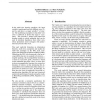Free Online Productivity Tools
i2Speak
i2Symbol
i2OCR
iTex2Img
iWeb2Print
iWeb2Shot
i2Type
iPdf2Split
iPdf2Merge
i2Bopomofo
i2Arabic
i2Style
i2Image
i2PDF
iLatex2Rtf
Sci2ools
103
Voted
COLT
2008
Springer
2008
Springer
An Information Theoretic Framework for Multi-view Learning
In the multi-view learning paradigm, the input variable is partitioned into two different views X1 and X2 and there is a target variable Y of interest. The underlying assumption is that either view alone is sufficient to predict the target Y accurately. This provides a natural semi-supervised learning setting in which unlabeled data can be used to eliminate hypothesis from either view, whose predictions tend to disagree with predictions based on the other view. This work explicitly formalizes an information theoretic, multi-view assumption and studies the multi-view paradigm in the PAC style semisupervised framework of Balcan and Blum [2006]. Underlying the PAC style framework is that an incompatibility function is assumed to be known -roughly speaking, this incompatibility function is a means to score how good a function is based on the unlabeled data alone. Here, we show how to derive incompatibility functions for certain loss functions of interest, so that minimizing this incompati...
Related Content
| Added | 18 Oct 2010 |
| Updated | 18 Oct 2010 |
| Type | Conference |
| Year | 2008 |
| Where | COLT |
| Authors | Karthik Sridharan, Sham M. Kakade |
Comments (0)

